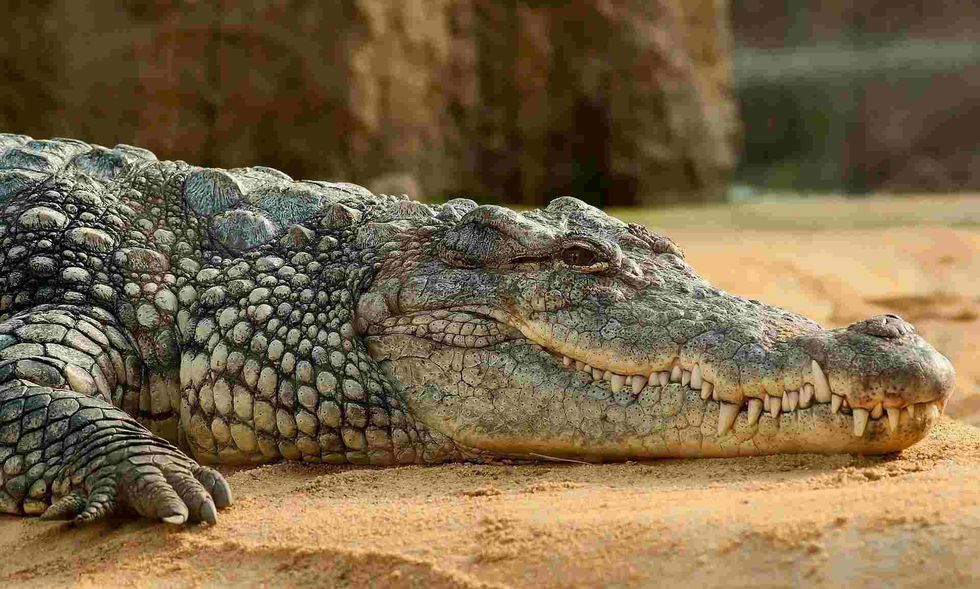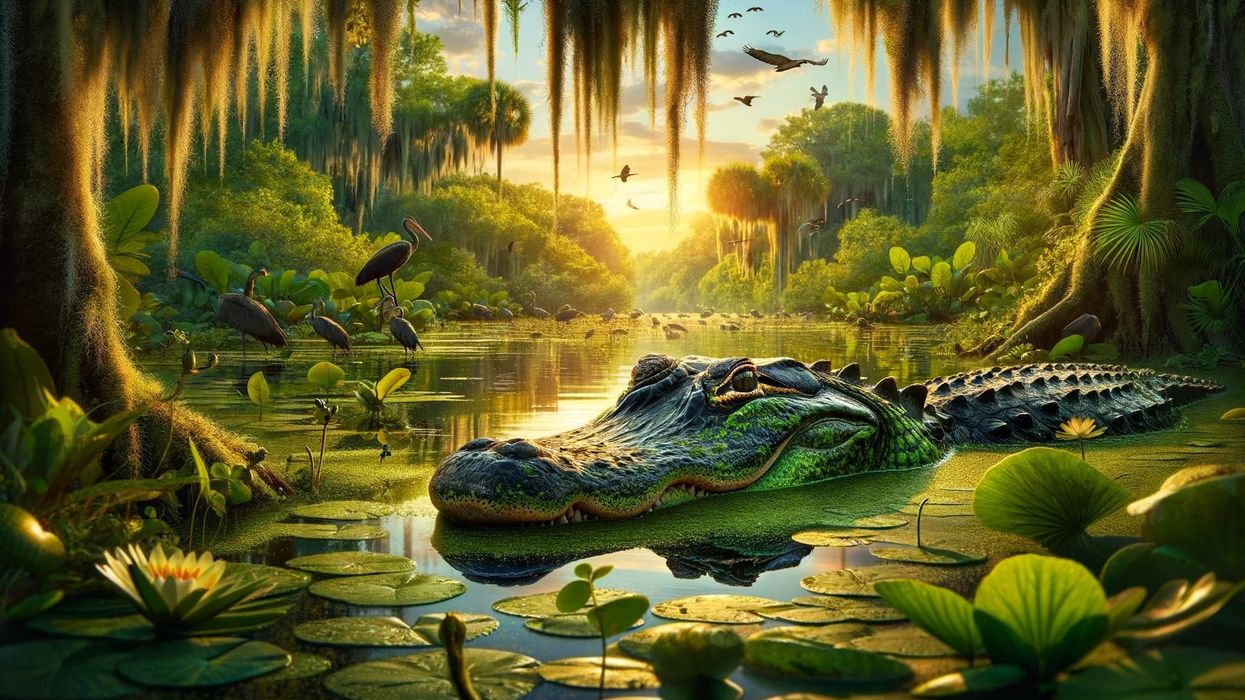The fastest crocodile species in the world is the Australian freshwater crocodile, which can reach speeds of about 10.56 mph (17 kph).
All crocodiles are social and vocal creatures. However, saltwater crocodiles are quite aggressive over their nest or territory.
A crocodile, also called a true crocodile, is a large-sized semiaquatic reptile species occupying the tropics in Asia, the Americas, Australia, and Africa. Crocodiles feed on mammals, fish, birds, reptiles, and even invertebrates like crustaceans and mollusks.
Caimans, gharials, and alligators might have identical appearances to crocodiles, but they all are of different families within the same order. It is easier to differentiate between gharials and crocodiles due to their long narrow snouts.
Alligators and crocodiles do not seem to have any difference, but there are small differences such as the head and the protruding teeth of crocodiles that are not seen in alligators. There are also morphological, size, behavioral, and ecological differences among crocodile species.
Crocodiles are carnivorous and occupy freshwater habitats like wetlands, lakes, rivers, and even saltwater and brackish water. They are well-adapted to tropical regions and are extremely sensitive to cold weather.
Many species of crocodiles are currently under threat. There are 17 recognized extant species of crocodiles.
Crocodiles soak up heat from either warm water or the sun during the day whenever they feel cold, like after a meal or if they feel groggy. They need to warm up as heat raises their metabolism.
Crocodiles might appear slow; however, they make use of the force and the size of their body to push themselves. Crocodiles that are under threat mainly face decline due to the leather industry. They are also hunted for meat in some parts of the bushmeat trade.
If you enjoy reading these facts about how fast can a crocodile run, then make sure to read some more interesting facts about can alligators hear and how do alligators mate here at Kidadl.
Can a crocodile outrun a human on land?
If a race was to be conducted between humans and crocodiles, humans would obviously win, as crocodiles cannot outrun humans due to not having enough stamina and endurance on the ground.
Crocodiles do not really come across as fast runners; however, they can run faster than many humans. Crocodile species can swim up to a top speed of around 12.4 mph (20 kph) and run as fast as 10.5 mph (17 kph).
When running on their belly, crocodiles reach an average speed of around 7.4 mph (12 kph). They cannot run for long distances.
Some sources state that a crocodile's average speed is around 22 mph (35 kph), but this is a myth because no crocodiles, freshwater or saltwater, have ever been recorded to be running at this speed. Also, for any particular measurement, it is necessary to know the conditions around a running crocodile.
Crocodiles live in swamps, lakes, and rivers. Crocodiles are typically better at swimming than running.
Their jaws are built stronger than their legs. They can swim faster than humans but can not run faster than human beings.
On land, crocodiles cannot outrun a human being but in water, crocodiles can move faster than human beings can. Legs of crocodiles are not designed in the same way as legs of humans.
Although their legs are human-like with Achilles tendons similar to humans, they do not function in the same way. These Achilles tendons in crocodiles are typically made up of cartilage and are weaker than that of humans. Crocodiles' feet are designed differently when compared to humans.
The feet have no heels. Crocodiles can attack a human if the human is immobile or injured.
A crocodile's body is made for its aquatic lifestyle. A crocodile has a streamlined body that decreases water resistance and accommodates swimming activity. Although crocodiles do not use their webbed feet to propel through water, they use them to make sudden and fast turns or moves in the water or even to initiate swimming.
In shallow water, they use their feet to move on the ground. This makes them skilled swimmers.
Do crocodiles have three gaits?

Crocodiles have three gaits: a slow gait, a high walk, and a gallop.
Styles of locomotion or gait define the way crocodiles move on the land. Their usually slow gait is called a belly crawl and the crocodile will slide using a slippery surface like mud and uses its legs to push the body forward.
A crocodile can modify this move by running quickly, often to get away from any kind of threat.
This faster gait is called a belly run where the crocodile's legs operate from the side rather than under the body. The second type of gait is called a high walk in which the crocodile's body is erect with its legs right under the body.
This is a normal way to go around and the crocodile lifts itself to avoid any kind of belly friction against obstacles like rock or soil on the land. Although this walk is used for short distances, crocodiles are able to hike for long distances.
Again, when they need to get away from a threat the belly run is used where they move forward in a sinusoidal wave almost like swimming on the land.
The flexion helps with the positioning of the limbs when the crocodile contacts the land. This gait also allows the crocodile to quickly swim away as it approaches the water.
The second fast gait used on land is the gallop, where both limbs move in sync and it almost looks like a rabbit's hop. While the hind legs push the body forward lifting it into the air, the front legs take the impact.
The gallop gait can be seen in many crocodile species although it is mostly used by smaller crocs. Belly running is a slower gait than the gallop.
Galloping is best used on firm ground as crocodiles can easily avoid any low obstacles and head to the water. While most crocodile species tend to run away really fast others might just gallop and attack the threat.
It was previously believed that only Australian freshwater crocodiles could bound or gallop. However, recent studies and research indicated that this gait behavior is more common among crocodiles.
It was also recorded that almost all the species were able to reach the top speed no matter the size. When compared to caimans and alligators, crocodiles were the only ones that used their legs for asymmetrical strides providing longer strides. This is particularly true for small-sized crocodiles.
Do some crocodiles run at different speeds?
Yes, some crocodiles run at different average speeds depending on their size.
There are almost 15 types of crocodiles that are spread across five continents. A large American saltwater crocodile can reach up to 20 ft (6.1 m) making these crocodiles the biggest species.
American saltwater crocodiles are called so because they can easily tolerate saltwater. You can identify this species by the large hump in front of its eyes.
The heaviest of crocodiles is the Nile crocodile. The smallest species is the dwarf or African dwarf crocodile. Dwarf species can only reach up to 4.9 ft (1.5 m).
There are other large and medium-sized crocodiles like the saltwater crocodile, the mugger crocodile, the freshwater crocodile, the Murelet's crocodile, and the Philippine crocodile. The saltwater crocodile and the Nile can also reach the same speed as American saltwater crocodiles.
Depending on size, the speed varies from one species of crocodile to another. The Nile crocodile also weighs almost 20 times more than the weight of the dwarf crocodile.
Here are some top running speeds of a few crocodiles:
- The speed of the dwarf crocodile (Osteolaemus tetraspis) is 11 mph (17 kph)
- The saltwater crocodile (Crocodylus porosus) runs at a speed of 15-18 mph (24-29 kph)
- The American crocodile (Crocodylus acutus) has a top speed of 20 mph (32 kph)
- The Nile crocodile (Crocodylus nilotycus) runs at a speed of 19-22 mph (30-35 kph).
These speeds are attained by crocodiles only for a short distance.
Why doesn't crocodile speed really matter?
Crocodile speeds do not matter because this animal is known to capture prey animals with a surprise attack and will not chase down prey to get hold of it. So, they are usually no danger to human beings.
When a crocodile runs from danger it uses one of three gait motions usually to escape. Crocodile species are also known as ambush predators, hunting prey by surprise attack.
The crocodile does not chase prey around. For large prey, a crocodile uses a death roll where, after drawing in prey, the crocodile rolls in the water for easy removal of the limbs of its prey. The crocodile's teeth are only used for gripping and not for tearing up the flesh.
Like mentioned earlier, crocodiles tire out faster and only move for a short distance. So, when you actually see a crocodile run towards you, you know what to do, run! However, when a crocodile does not move an inch, that is a real danger.
A crocodile has low stamina and endurance on land but while attacking by surprise it has great precision. The attacking move is also quite fast.
We now know that crocodiles do not chase prey and it is physiologically not possible for them to run long distances. If they do move at great speeds it is either to move away from a threat or to cover the distance between them and their prey before attacking with one fluid movement.
If you happen to be an intruder then to defend their territory and nest female or male crocodiles will launch themselves after you.
However, this is for a short distance; they will retreat once the intruder is out of their surroundings.
Crocodiles are not the usual sluggish and slippery animals they are often portrayed as but can take down prey within moments. Crocodiles will not win in a race with cheetahs.
Here at Kidadl, we have carefully created lots of interesting family-friendly facts for everyone to enjoy! If you liked our suggestion for how fast can a crocodile run, then why not take a look at how many teeth do alligators have or crocodile facts?









